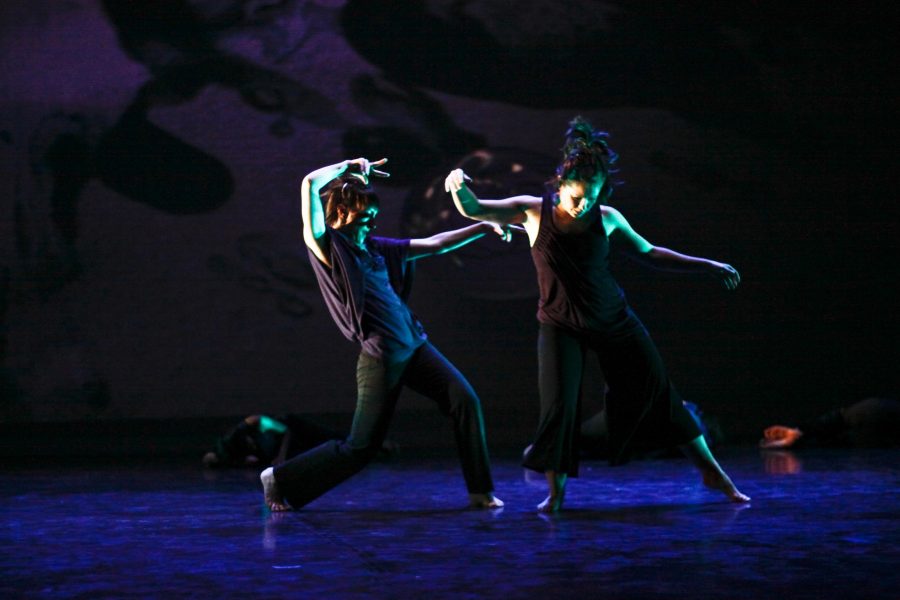Krannert Center’s ‘February Dance’ blends technology and environment
Photo Courtesy of Natalie Fiol
Dance students rehearse for February Dance, which has integrated technological advancements so the audience can interact with dancers. The show will be performed Thursday through Saturday at the Krannert Center for the Performing Arts.
Feb 2, 2017
A combination of environmental influences blended with technological advancements and human interaction form the theme of the February Dance.
The annual February Dance will be held Thursday through Saturday at 7:30 p.m. Tickets are $23 for adults, $21 for senior citizens, $17 for non-University students and $10 for all current University students and children. February Dance is one of the celebrations commemorating the University’s sesquicentennial anniversary.
The performance includes four pieces, choreographed by Charli Brissey, Rebecca Nettl-Fiol and John Toenjes with guest artist, Chad Michael Hall and Renée Wadleigh. All of the pieces stem from contemporary and modern dance, and also incorporate electro-acoustic music and original scores from Ken Beck, Jason Finkelman and Toby Twining.
Approximately 40 dancers will be showcased in the concert, which is dedicated to Wadleigh, who retired from the University in December.
This year’s performance explores the mutual relationship between humans and the environment around them, or Designed Environments. Each piece expresses this theme in its own way, whether it be through lighting, costumes, technology or set design.
Get The Daily Illini in your inbox!
“The idea of how we shape our space is how we live and how we think. A major part of understanding ourselves is how we shape our environments,” said Jan Erkert, professor and head of the dance department. “The theme brings about the sense of how our environment is changing with technology and how that’s allowing us to act with our environment in many new ways.”
Designed Environments also help the audience better understand the meanings behind the pieces and how they relate to each other.
“I think the audience can look for a general theme throughout the show about how the choreographers use space alternatively and are really doing cool things with technology and putting you in a different atmosphere,” said Jenny Oelerich, sophomore in FAA. “Even though all four pieces are very different, I think that will be the common thread throughout the whole show.”
This year’s dance stands out from the University’s past dance performances because of its utilization of technology. This year, an app will be used throughout John Toenjes’s piece titled “Critical Mass.” Developed by Tony Reimer, professor of sound design, the app serves as a way for the audience to be directly involved with the show. Audience members will have the opportunity to go on the stage and interact with the dancers. They will also have the ability to control things, like the direction of the dance and the lighting in the auditorium from their seats.
“It came about from computer technology, where you design an environment or space that is activated by motion capture,” said Toenjes, associate professor and undergraduate director of dance. “The space is just there until you activate it. People come into the environment, and because the people are there the environment changes. We’re using the cell phones as a way for the audience to influence the course of the dance.”
One of the main features of the app is it explains the meaning and inspiration behind the dancers’ choreography. This feature will be beneficial to audience members who often find it difficult to understand contemporary dance. The app also helps the audience better relate to the dance and understand the emotion behind it.
“In our dance, there’s a section where the cast is dancing solos that they all choreographed with ideas in mind about social media,” Toenjes said. “They each have an identifying logo on their costume, and we have buttons that match those logos on the app that explain what motivated them to create those movements.”
Aside from Toenjes’s piece, the three other pieces are titled “In the String Room” by Nettl-Fiol, “Therapoda” by Brissey, and “The Quench” by Wadleigh.
Nettl-Fiol’s piece was inspired by the Greek myth of Eurydice, specifically the story of Eurydice’s journey to bring his wife Orpheus back from the underworld. It explores the metaphors of water, string and the underworld and displays animated pictures projected behind the dancers.
“It’s not a narrative with some kind of story but I think it reads as something other than abstract movement. Everybody brings their own experience of watching it and appreciation of movement,” said Nettl-Fiol, professor and undergraduate recruitment director of dance.
Erkert said the best takeaway of February Dance is the professionalism the rehearsal process teaches students and the student-faculty relationships made. These experiences provide students with the skills they will need in both the professional world of dance and their careers at the University.
“The whole show is collaborative with students and faculty. It’s an incredible chance for students to work with guest artists and faculty throughout the whole process of learning a dance and choreographing and performing it. We think of the Krannert Center as a living laboratory where they learn to make work in a professional way,” said Erkert.
February Dance is a representation of the research and experimental attitude that dance the University displays.
“If you haven’t seen dance before and aren’t familiar with it this is a great way to expose yourself to this art form. Also, it’s a very diverse show too, all the pieces are very different stylistically and I think no matter where you’re coming from you can find something that you’ll connect or relate to,” said Oelerich.






